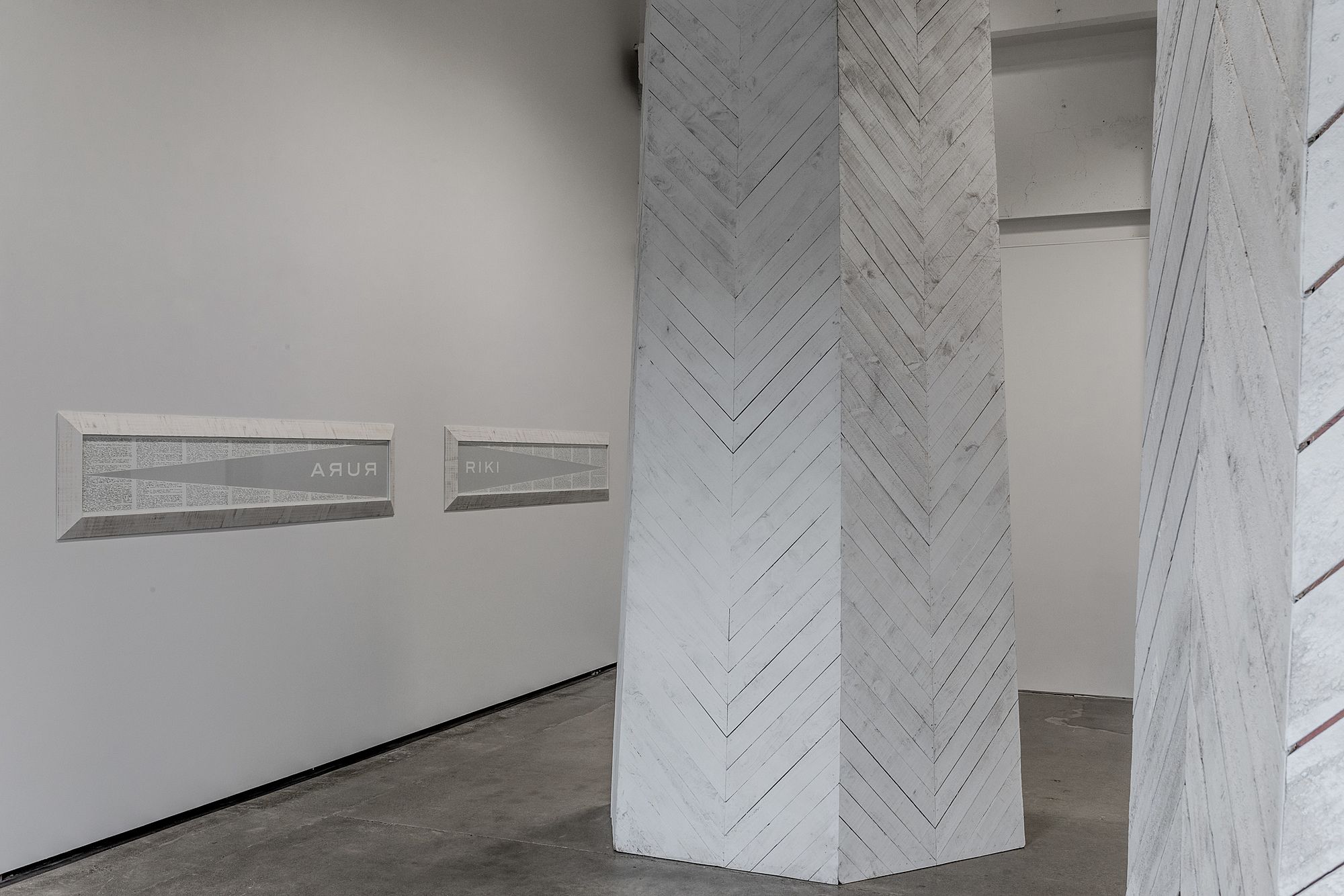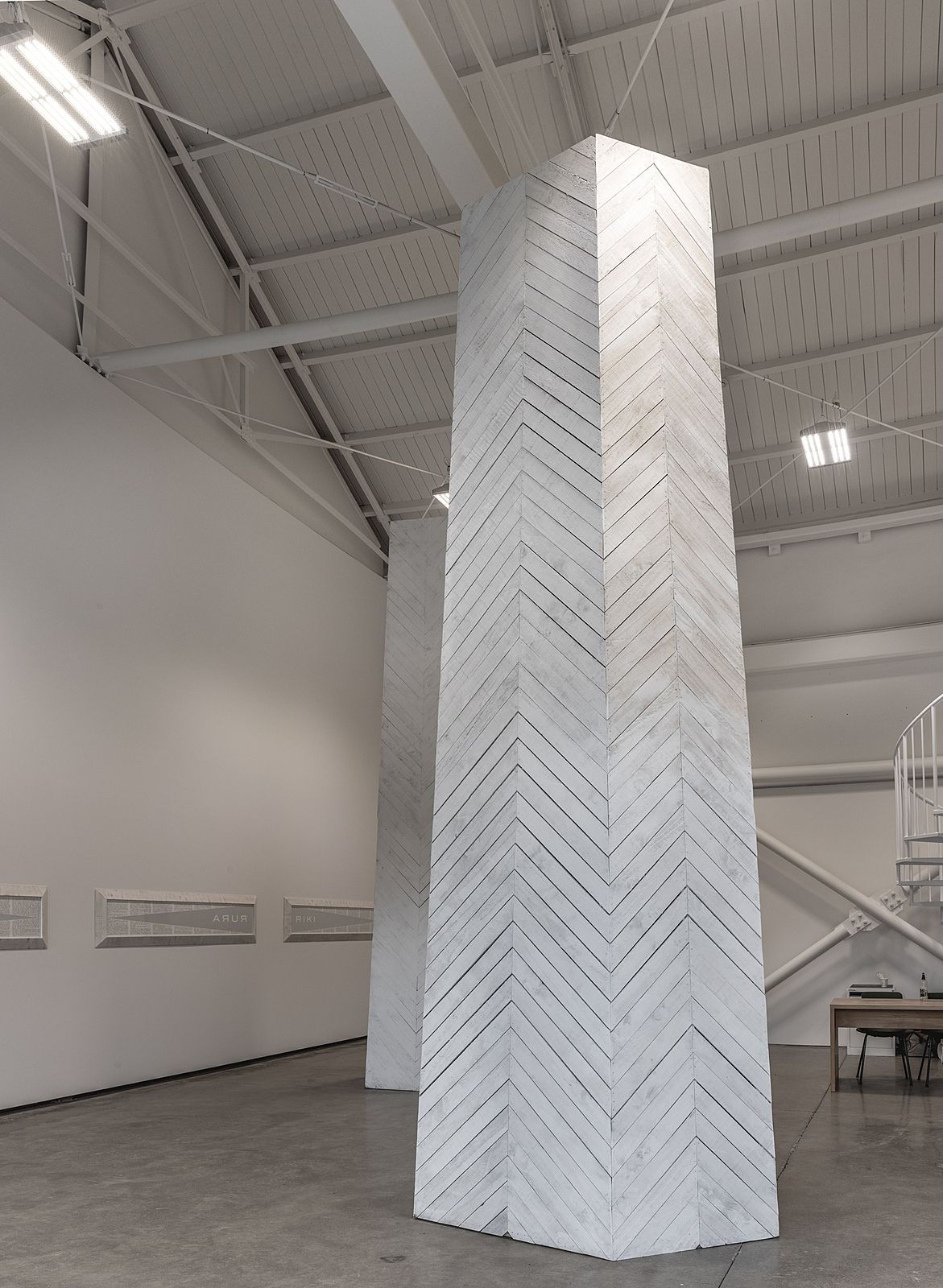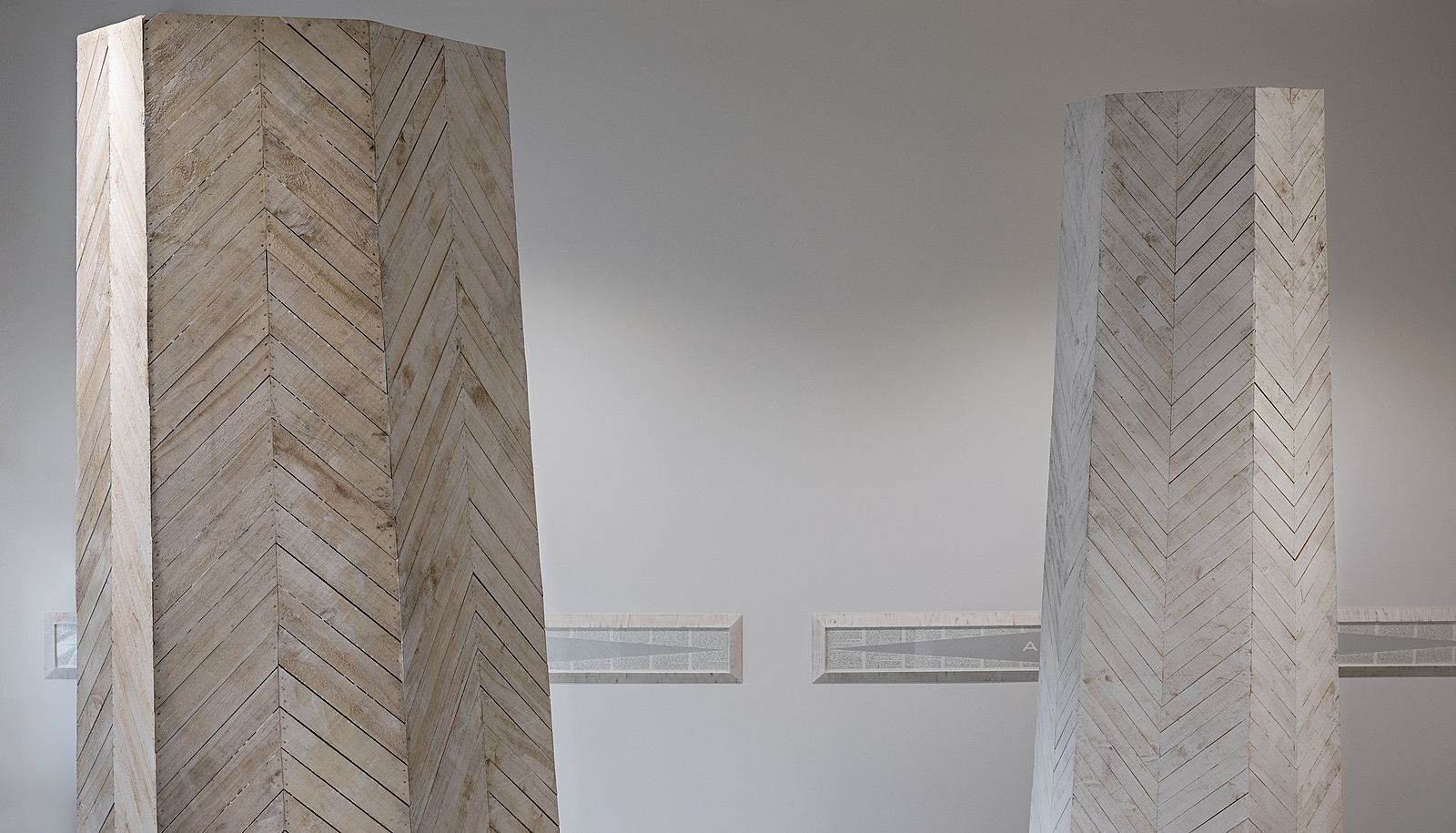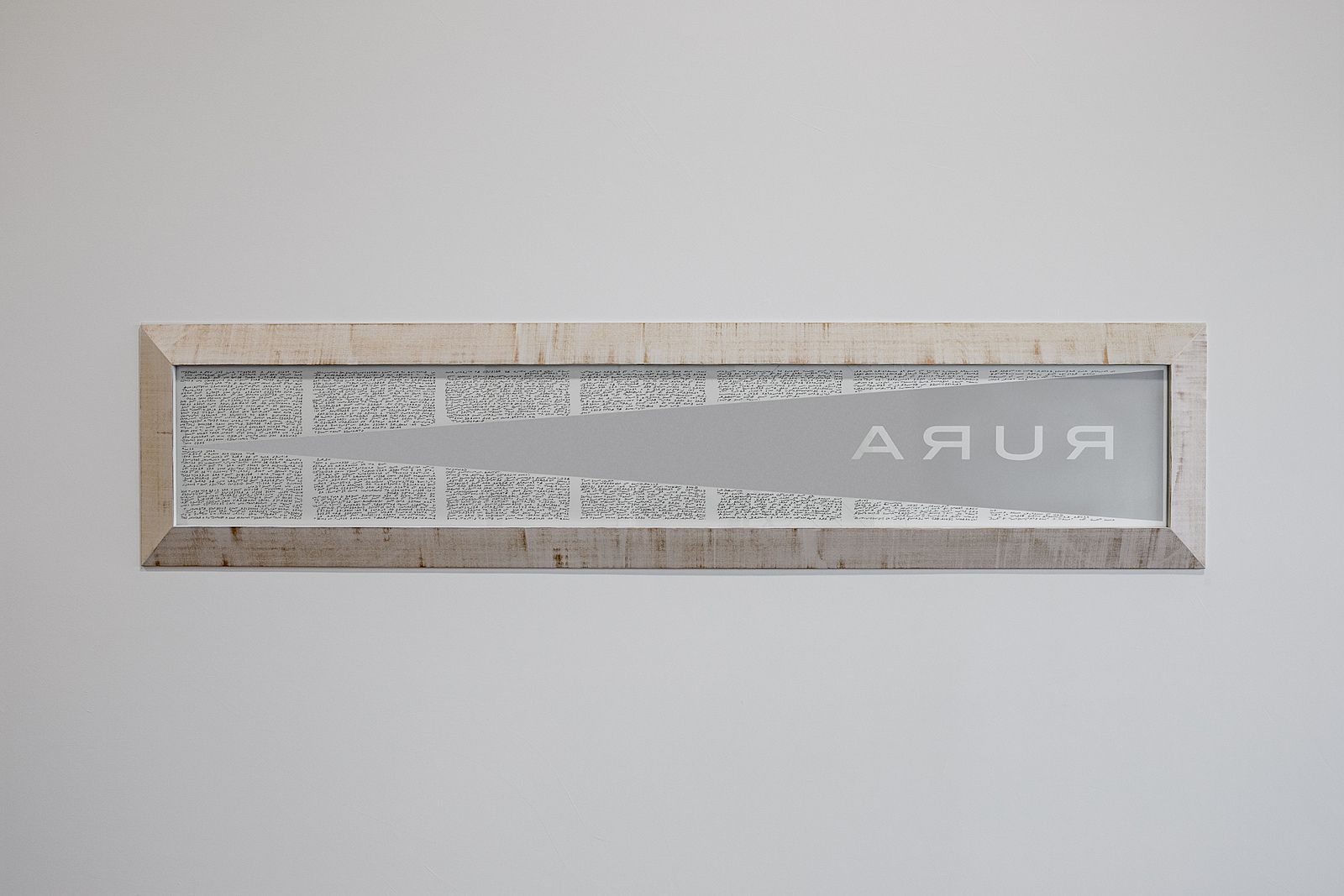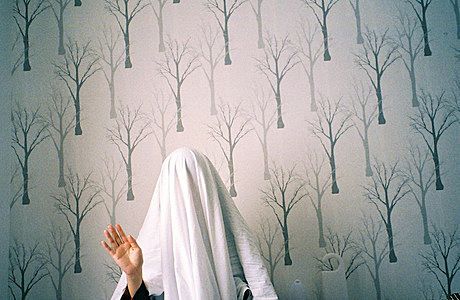Contentious Histories: A Review of Properties of Peace and Evil
The importance of challenging history, Jessica Douglas on Brett Graham's recent exhibition.
The importance of challenging history, Jessica Douglas on Brett Graham's recent exhibition.
"Who controls the past controls the future: who controls the present controls the past," reads the slogan of the totalitarian Party in George Orwell's dystopian novel Nineteen Eighty-Four (1949), a book which I was reading during my stay in Hawke's Bay last weekend.
While in Hastings I got the chance to see Brett Graham's exhibition at Parlour Projects, Properties of Peace and Evil. When I first entered the gallery's doors I was somewhat blinded by the crisp whiteness, and felt very conscious of my own Pākehā skin. Overcoming this, I was awestruck by Graham's enormous site-specific installations. At five metres high, his two columns quite simply commanded attention. Alongside these pillars were four paper works running alongside one another on the east wall. Together with the columns, this exhibition created a conversation around the preservation and perspective of history and power.
There was a power that reverberated within these panelled structures. The columns are reminiscent of niu (new) poles that were totem of the Pai Mārire faith and, in their day, were constructed from ships' masks. Pai Mārire was developed as a religion of peace in 1862 by the Māori prophet, Te Ua Haumēne. Though baptised Horopapera (Zerubbabel) in the Wesleyan faith, he changed his name to Te Ua Haumēne (wind man) in 1864 after he communicated with God on the breath of the wind (hau). His followers became known as Hauhau.
Pai Mārire has in the past been written about as a religious cult whose members were savages and cannibals. For instance, in his book Hauhau: The Pai Marire Search for Maori Identity (1975), Paul Clark looks at an 1865 report from settler John Hervey who wrote that the Tūranganui Māori were determined to adhere to “Hauhauism” and be “wild, cannibal savages…” As a result, the Pai Mārire are synonymous with the debasement of humankind and something to ogle or marvel at – a bit like those in Jono Rotman’s controversial Mongrel Mob Portraits (2007-present). Because they have been regarded as such, Graham suggests that the Pai Mārire’s history has not been examined critically or objectively. And so he took it upon himself to create a platform for this conversation to take place. Properties of Peace and Evil is the result.
His work is contentious, which he acknowledges and recognises and is something he wants people to engage with. It’s a chance for conversation.
When I was visiting Graham’s exhibition, he fortuitously happened to be in the café next door. After a quick introduction, he was more than open to a spontaneous get together. We nestled into a corner table and talked about his show for some time. He spoke gently, with a calm and relaxed demeanour; open and honest, just like his works in the exhibition. He doesn’t mind if people have differing opinions. His work is contentious, which he acknowledges and recognises and is something he wants people to engage with. It’s a chance for conversation.
The tall, willowy poles are the most attention-grabbing part of the show. They not only evoke Pai Mārire’s niu poles but also allude to the stone obelisks that were erected at Pētane and Ōmarunui in 1916. These were installed by the veterans of the Battle of Ōmarunui to commemorate the battle’s 50th anniversary, and were later smashed in protest in the 1990s. The Battle of Ōmarunui is a contested one. What happened is still largely unknown and as a result, conflicting perspectives exist.
History books have it that in early October 1866, Pai Mārire prophet Panapa and Ngāti Hineru chief Te Rangihiroa led 80 men in an advance on Napier, and the party occupied Ōmarunui. Then, on 12 October 1866, under the command of Colonel George Whitmore, approximately 200 militiamen and 200 local Ngāti Kahungunu surrounded the party of Pai Mārire/Hauhau followers.
However, in the Waitangi Tribunal Report of 2004, it is suggested that Donald McLean inflamed pre-existing hostility between the Crown and some other chiefs towards Pai Mārire, by inviting Pai Mārire to Napier and then pretending as though he didn’t, leaving the group defenceless.
The Pai Mārire’s invitation to surrender was refused, and a one-day battle followed. The occupied kāinga was besieged, many Ngāti Hineuru were killed, and those remaining were taken prisoner and exiled to Rekohu in the Chatham Islands along with whānau who were taken prisoner at Herepoho near Pētane. Ngāti Hineuru also had 295,000 acres of their land confiscated due to ‘rebellion against the Crown’. Which, conveniently, enabled the construction of the Napier-Taupō road.
The questions Graham raises in this exhibition in terms of cultural superiority, construction of identity politics, and control over history and storytelling are interesting, albeit challenging.
I admittedly knew nothing about this battle before this exhibition, but I’m glad my attention has now been brought to it. The questions Graham raises in this exhibition in terms of cultural superiority, construction of identity politics, and control over history and storytelling are interesting, albeit challenging.
In his artist statement, Graham draws our attention to Pākehā historians [James] Cowan and [Dr John] Battersby, both of whom chose to ignore the correspondence between Superintendent of the Hawke’s Bay Province Donald McLean and the aforementioned prophet, Panapa.
At the arrival of Panapa’s party of Pai Mārire followers, McLean questioned whether the purpose of the group’s expedition was “for evil or for good”. Panapa responded in writing in Māori:
Kia ma
te Rapaki 8 Oketopa /66
Tenei kua tae mai tau reta na noa raua ko & Rueti i kawe mai kua kite matou e na ana koe, ae kia rongo mai koe he taonga tonu te pai & he taonga tonu ti kino, moto iu te na ki, ta matou mahana hoki kaore ano matou kia whakawahia e koutou ko nga Rangitira k ate mea i te ara ano matou kia mai e haere ana awhakahoki noa koe he oi kua mutu te korero.
Na matou katoa
At the time this was roughly translated into English as:
To Mr. McLean,—
Te Rapaki, October 5, 1866.
We have received your letter brought by Noa and Edward (My Hamlin); we see that you are asking Yes. Do you listen, Peace is a property and evil is also a property. This is the answer to your question: One thought it that we have not yet been judged by you and the chides, since while we were on the road we were sent back by you. Now talking is at an end.
To Mr. McLean.
From us all.
I say roughly because, as with all translations, not only was the language structure changed but a colloquial expression was lost. The final line, ‘kua mutu te korero’ is a friendly signoff akin to, ‘that is all for now’; however, it was assumed to mean ‘Now talking is at an end’. Thus taken by McLean as an unequivocal and rather severe endpoint, Panapa and his followers’ fates were sealed and history was made.
The differences conveyed by these two lines signal the theme of opposites, which runs throughout the exhibition. We see this with the properties of peace and evil, as laid out in Panapa’s letter and which the exhibition title takes its name from. Furthermore, while the practice of Pai Mārire incantations offer spiritual and peaceful solace, ‘Hauhau’ has become synonymous with evil. Born in worn-torn Taranaki, the religion and its members were involved in renewed fighting and their chants included ritualised military phrases. When they chanted ‘hauhau’ it was interpreted as aggressive. (See the Te Ara webpage on Te Ua Haumēne for more details). We also see ideas of opposition with the dichotomy between Graham’s view of the battle and others, such as historians, writers and artists, including Jono Rotman.
Rotman’s 2016 exhibition at Parlour Project, Ōmarunui, thematically examined the Ōmarunui battle with photographic residue of the event. Coinciding with the battle’s 150th anniversary, the show contributed to the commemorative events around Hawke’s Bay and was positively received. According to Rotman's artist statement, each work shared an "act of transference to the past". He continues, "I hope for the work to be of most use to those directly related to it, adding dimensions to the evolving relationship with history and nourishing a present that is inextricably connected to difficult events in the past." His show included five glass-plate negatives from the Alexander Turnbull Library, four of which were portraits, alongside a sixth work of a photograph of the Ōmarunui obelisk memorial.
The deliberate rupturing of this 2.4 metre granite obelisk by protestors in the 1990s serves as a reminder that the event is still contested and lives on in the minds of the present. In creating his own poles, Graham is perhaps providing a cenotaph to the taken lives of the Pai Mārire – to those who never received their own memorial.
Though most onlookers likely would not realise, the two poles are subtly different. One has diagonal wooden slats meeting upwards, perhaps pointing to heaven or ‘peace’, and the other has them meeting downwards, pointing to hell or ‘evil’. The difference is so slight, recognising how minute detail can often be overlooked, and how two different things can still be the same to some.
As large-scale installations so often manage to do, in looking at the poles my attention was drawn to the large, open exhibition space. Following the structures’ daunting height, my eyes scaled the walls to the ceiling and beams, spanning the gallery's corners and floorboards and mezzanine.
The poles themselves are set to perfectly match the Parlour Projects flooring and pristine white walls with a rubbed white finish; ‘whitewash’ some might say. These structures are clad in wood from the region to evoke houses from the period and are, as Graham describes in his statement, “symbolic of the fact that the ‘Hauhau’ had occupied not a redoubt or fortified position but were in a ‘papa kainga’, a domestic dwelling unsuitable for defence”. Not only are the poles temporary, but the paint grips the rough wooden finish with featherly-fine delicacy.
At a distance, the two poles look like they are in conversation – they face each other as they speak; they are staunch and tall with shoulders back and heads held high. They are also in conversation with four works on paper, whose wooden frames feature a similar white finish. Graham had these frames specially designed to look like C. F. Goldie’s. While Goldie used sleek black frames to encase his Māori figures, Graham symbolically uses white ones to share an untold history of perspectives and identity.
These works, Riki and Rura and Riki (inverted) and Rura (inverted) each feature seven tidy columns filled with pencilled speech, drawn out in Graham’s neat handwriting. The columns’ pencil outlines are still faintly visible. Graham easily could have rubbed out these borders, but instead of erasing the work’s foundation he displays it – even if it is a bit messy. There’s certainly a metaphor in that.
Contained within the columns are email exchanges with Jono Rotman, excerpts from history books, and Graham’s own ramblings. Though beautifully laid out, Graham’s speech across the four works is without prose and difficult for your eyes to follow. It takes a long time to read (it took me a good twenty minutes) and oftentimes comes across staccato. I have to wonder whether most people would even bother to read it. Ignorance is bliss? It turns out that Graham never expected people to, but he’s delighted that some people are. Oftentimes writing down one’s thoughts is like a kind of therapy: purging yourself of the omens that chase you. Whether or not people read them is irrelevant.
The writing in each work is pierced by a grey triangle, its point stretching across the width of the passage. Its shape alludes to a flag or a sharp-edged blade. Flags, an important part of Aotearoa’s history, are a sign of the past and here they splice into Graham’s contemporary speech, an allegory for how history is always on the surface of things.
The four works are set out in pairs, which are representative of Archangels Michael Riri (Āriki) and Gabriel Rura (ruler). Te Ua (Pai Mārire’s founding father) had a vision after the dramatic wreck of mail steamer Lord Worsley near his home in 1862. On 5 September that year, Te Ua gave a pronouncement that Archangel Gabriel had spoken to him, announcing the last days as foretold in the Book of Revelation. Te Ua’s teachings focused on Gabriel as Rura (ruler), and during times of war his guardian angel was Archangel Michael. Deities of peace and evil, they were carved onto niu cross arms or represented by flags.
Of his exhibition, Graham says, “the result is not something that is a Māori/Pākehā thing.” Rather, it’s about the cornerstone of Aotearoa's identity; about a specific time in New Zealand's history which saw Māori respond to British imperialism and thus a shift in power from Māori chiefs to Crown sovereignty. New Zealand history is often portrayed as Māori and Pākehā coming together to fight a common evil (in this instance, the Pai Mārire), but in actuality it goes far beyond this. Graham continues, “It’s interesting to look at this history and how the obelisks were used as a narrative to enforce this [united] ideal, particularly as they were erected shortly after the Gallipoli Campaign.” The smashing of these monuments demonstrates that the public want an open-conversation and a history that isn’t one-sided.
It’s a rather intimidating thing to do, to lay your beliefs out for people to poke and prod at, to scathingly question and comment on – particularly in a space as public as a gallery. “Stupid, too,” Graham offers.
During the exhibition’s two and a half week cycle however, some members of the public couldn’t handle the contention and chose to exit the gallery. Others didn’t understand where the art was. Yet, the challenging nature also brought about a number of new faces to the gallery and several repeat visitors who had been thinking about the issues raised in Jono Rotman’s exhibition in regards to the battle and the way it had been portrayed historically. Moreover, some people stayed upwards of an hour to truly engage with Graham’s work, which is fairly unprecedented in a dealer gallery. By testing and creating this conversation around the boundaries of what art is and can do, Graham excels in doing his job as an artist and storyteller (or, perhaps, history teller).
The strength of Graham’s formidable exhibition is in its ability to wittingly challenge history: to constantly question the imagery and histories presented before us; to neither forget nor forgive. After all, as Orwell reminds us, historical narratives start from a position.
It’s a rather intimidating thing to do, to lay your beliefs out for people to poke and prod at, to scathingly question and comment on – particularly in a space as public as a gallery. “Stupid, too,” Graham offers. Days after seeing the show, I am left thinking about my – about our – ability to make conscious choices. Like those who fought in the battle, and those who have subsequently engaged in its history as perhaps a historian or writer, artist or protestor, sides can be chosen and beliefs must be made. I think we should take a cue from the artist and never cease to challenge.
Parlour Projects
12 July 2017 – 29 July 2017
All images courtesy of the artist and Parlour Projects
